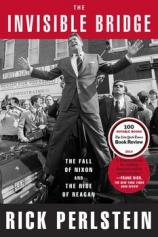The Invisible Bridge: The Fall of Nixon and the Rise of Reagan
Review
The Invisible Bridge: The Fall of Nixon and the Rise of Reagan
“The past isn’t dead,” wrote William Faulkner, “it isn’t even past.”
Reading Rick Perlstein’s magnificent new book, THE INVISIBLE BRIDGE: The Fall of Nixon and the Rise of Reagan, reminds readers how prescient Faulkner’s observation was. Perlstein’s third epic historical study focusing on the rise of modern American political conservatism is replete with historical anecdotes and facts that serve as reminders of American political battles that have been fought for decades --- and are still being fought today. Little has changed in many political debates, with the same political arguments being presented and the same political sound bites being spoken. All that seems to have changed over the past 40 years are the names of the politicians and the number of media outlets and microphones available to them for their inflaming political rhetoric.
The book covers a brief but monumental period of three years --- the years when Richard Nixon’s disgracing of the Presidency became public and Gerald Ford nearly became the second sitting President to be denied his party’s nomination. It follows BEFORE THE STORM: Barry Goldwater and the Unmaking of the American Consensus, which focused on the beginning days of conservatism as it erupted into a mass political movement. NIXONLAND: The Rise of a President and the Fracturing of America, was the second volume. The massive scope of these books have brought Perlstein deserved critical acclaim, and a final installment culminating in the election of Ronald Reagan in 1980 concludes the saga.
"THE INVISIBLE BRIDGE is an extraordinary book, massive in scope and detail, and essential to a complete understanding of our nation’s politics."
THE INVISIBLE BRIDGE is the story of the political demise of Richard Nixon, who, in a period of two years, achieved America’s greatest political victory and then our nation’s most ignoble political disgrace. In 1972, Nixon won re-election by more than 18 million votes, the largest electoral victory in American history. In August 1974, he became the first American President to resign from office. Perlstein recreates the Watergate scandal leading to Nixon’s impeachment and resignation, as well as the companion resignation of Vice President Spiro Agnew and the nomination of Gerald Ford as Vice President. Through the series of events surrounding Nixon and Agnew’s criminal conduct, Ford would become our nation’s first un-elected President.
For anyone who lived through and recalls the years of Watergate, Perlstein’s account of the events is truly remarkable. In contemporary American politics, the first hint of a scandal brings the media into fierce action. The tiniest hint of wrongdoing creates a frenzy of coverage and the ruminations of “talking-heads” who seem oblivious to facts. In the days of Watergate, the media was far more cautious. Most of them downplayed Watergate as a second-rate burglary, and Perlstein’s accounting of the scandal is riveting as he details piece after piece of incriminating evidence mounted against the Nixon administration. The Watergate hearings, nationally televised on the then-three networks, riveted the nation. Administration officials verbally sparred with attorneys and Senators, some of whom vigorously defended the White House until the evidence of guilt became overwhelming. Perlstein deftly reminds us of many political figures who correctly grasped the severity of the scandal and put country ahead of politics. Readers may wonder where those politicians have gone because neither American political party, with some exceptions, seems capable of producing such figures in contemporary America.
THE INVISIBLE BRIDGE parallels the downfall of Richard Nixon with the rise of Ronald Reagan. Perlstein acknowledges that writing about the actor turned Governor is difficult. Even before Reagan was victorious in his election as Governor of California, a polarity of opinions was established about him that continues to exist even 10 years after his death. On one side are those who view him as a rescuer, hero and redeemer; on the other are those who assert he was a phony, fraud or toady. Even his own children cannot agree on the real Ronald Reagan. Perlstein traces his political rise, commencing with his support of Barry Goldwater and his tenure as Governor. Extensive coverage of his presidency most likely will be left to other historians. But the debate continues as political discussions hinge upon both sides asking, “What would Reagan have done?”
Reagan’s greatest talent came from his acting career. He knew what his audience wanted to hear. His political career gained strength from his verbal attacks on the students of California. Even when advisors suggested he back away from that subject, he persisted: “I don’t care if I’m in the mountains, the desert, the biggest cities of the state, the first question is: ‘What are you going to do about Berkeley?’” The question itself would get applause each time. Perlstein believes that understanding the divergent views towards Reagan are essential to understanding the divides of contemporary American politics.
THE INVISIBLE BRIDGE is an extraordinary book, massive in scope and detail, and essential to a complete understanding of our nation’s politics. There are two contemporary historians who must be read by anyone hoping to understand American politics. One is Robert Caro, and the other is Rick Perlstein.
Reviewed by Stuart Shiffman on August 7, 2014
The Invisible Bridge: The Fall of Nixon and the Rise of Reagan
- Publication Date: August 11, 2015
- Genres: History, Nonfiction, Politics
- Paperback: 880 pages
- Publisher: Simon & Schuster
- ISBN-10: 1476782423
- ISBN-13: 9781476782423





